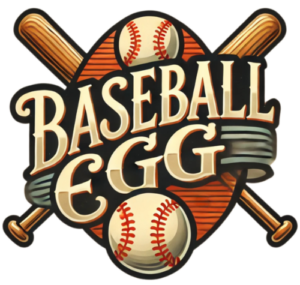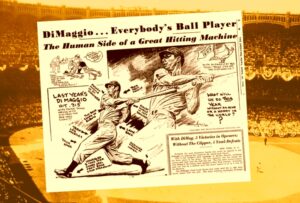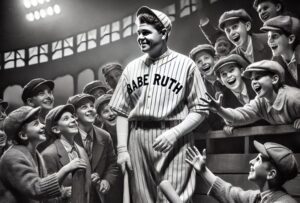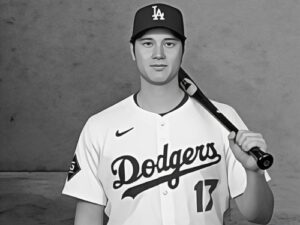New fans of baseball can find it confusing to understand the many types of pitches used by professional pitchers. Even seasoned baseball fans can find it difficult to understand the many pitches used by Major League pitchers.
This guide explains the most common pitches used in baseball.
Fastball
A fastball is a pitch that is thrown at a high velocity, usually in a straight line towards the plate. It’s one of the most common pitches in baseball, and is typically the fastest pitch that a pitcher can throw.
Fastballs are often used to get ahead in the count or to overpower the batter with speed. They can be thrown with different grips and techniques, such as the four-seam fastball, which is thrown with the fingers across the seams to maximize velocity and movement, or the two-seam fastball, which is gripped with the fingers along (or in alignment with) the seams to generate more movement.
Pitchers who are able to throw fastballs with consistent velocity and location can be very effective, as it can make it difficult for the batter to make solid contact with the ball. Fastballs are also often used in combination with the changeup, to keep the batter off balance and guessing.
A few of the greatest fastball pitchers in baseball history include Walter Johnson, Dazzy Vance, Bob Feller, Sam McDowell, Tom Seaver, Nolan Ryan, Roger Clemens, and Justin Verlander.
Reggie Jackson summed up the devastating nature of a fastball the best. He was asked why a fastball hitter such as him would have such difficulty with Nolan Ryan’s fastball.
“I love ice cream too,” Reggie said, “but I don’t like it shoveled down my throat a gallon at a time.”
Curveball
A curveball is thrown with spin that causes the ball to curve as it approaches the plate. the pitcher’s thumb grips the seam directly below the index finger, so the hand creates a backward “C.” The pitcher throws it with a snapping wrist motion, which imparts spin on the ball.
The spin causes the ball to move in a downward and lateral direction, which can deceive the batter and make it harder for them to hit the ball.
Curveballs can be difficult to throw and require extensive practice to master. They are often used as a surprise pitch or as a way to keep the batter off balance. They are also a popular pitch in baseball because they can generate a lot of swings and misses or weakly hit ground balls or pop-ups.
The “12-to-6 curveball” is a curve that breaks from over the top straight down. Other curveballs move from left to right or right to left and arrive from varying arm angles and release points.
A few of the pitchers famous for their curveball include Bert Blyleven, Sandy Koufax, Dwight Gooden, Jimmy Key, and Barry Zito.
Blyleven even had to admit that his patented curveball could have a frustrating impact on opponents.
“One curve I’ll always remember was when I was pitching for Pittsburgh,” Blyleven once shared. “Terry Kennedy was a young player with St. Louis. I threw him an 0-2 curve and it snapped. Terry’s reaction was to swing straight down, like he was chopping the plate with an axe. It was the last out of the inning. After I ran off the mound, I looked over at the St. Louis dugout. There were players rolling around on the floor, laughing. Poor Terry. I’ll have to admit that was a hell of a curveball.”
Slider
A slider is thrown with lateral movement, similar to a curveball, but with less downward movement. The slider is often thrown at a velocity similar to a fastball but with a different grip and wrist movement, which causes the baseball to break in a sweeping motion across the plate.
To throw a slider, the pitcher grips the ball with their index and middle fingers on one side of the ball and their thumb on the other side. They then use a snapping wrist motion to release the ball and generate spin, which causes the ball to break towards the pitcher’s glove side (for right-handed pitchers, this means the ball moves from right to left, and for left-handed pitchers, it moves from left to right).
Sliders can be difficult for batters to hit because the pitch appears to be a fastball initially, but then breaks away from them, making it harder to make solid contact. However, sliders can be difficult for pitchers to control.
The slider is a popular pitch in baseball in the 21st century, as it can be used to get strikeouts or induce weak contact from batters.
Pitchers noted for their effective sliders include Bob Gibson, Steve Carlton, John Smoltz, Randy Johnson, and Jacob deGrom.
Tim McCarver caught Gibson for years when they were teammates on the Cardinals. But even he had a tough time with Gibson’s famous slider.
“I called the pitches, so I knew what was coming,” McCarver said years later. “But there were times when I was missing pitches just like the hitters were. His slider could whip sideways six inches in less than a foot on top of the plate.”
Changeup
A changeup is thrown with the same arm action as a fastball but with a slower speed, usually 8-15 mph slower. It is often used to keep batters off balance by disrupting their timing and making it more difficult for them to make solid contact with the ball. Here are the steps to throw a changeup:
- Grip the ball: To throw a changeup, grip the ball deep in the hand, using a “circle change” grip. This means holding the ball with the thumb and three fingers, with the index and middle fingers together on one side of the ball and the thumb on the other side, forming a circle.
- Keep the arm action the same: The key to throwing an effective changeup is to use the same arm action as you would for a fastball. This means winding up and delivering the pitch with the same motion as a fastball, but with a slower speed.
- Use the fingers to create movement: To create movement on the pitch, focus on releasing the ball with a flick of the fingers, pulling down on the ball as you release it. This will create backspin on the ball, which will cause it to rise slightly and move in an unpredictable manner.
- Practice and vary the speed: To become effective at throwing a changeup, practice it regularly, experimenting with different speeds and grips until you find what works best for you. Varying the speed and movement on your changeup will make it more difficult for batters to anticipate and hit the pitch.
Throwing an effective changeup requires practice, patience, and experimentation. It can be a valuable weapon in a pitcher’s arsenal, allowing them to fool hitters and generate outs.
A few of the best changeups in baseball history were thrown by Satchel Paige, Pedro Martinez, and Tim Lincecum, as well as current MLB star Sandy Alcantara.
Knuckleball
The knuckleball is known for its unpredictable movement due to the absence of spin on the baseball. Unlike other pitches, which are thrown with spin to generate movement, the knuckleball is thrown with no (or minimal) spin and relies on air resistance to cause the ball to move in unexpected ways.
To throw a knuckleball, the pitcher grips the ball with their fingertips, with the nails digging into the seams to reduce the amount of spin. The pitcher then throws the ball with a high arc and a slight flutter, without any rotation or spin.
A properly thrown knuckleball can dart, dive, dip, and even rise because the air around the baseball imparts forces on the sphere that has seams. A knuckleball can be very difficult for a catcher to catch. Many catchers use a special larger glove to work with knuckleball specialists.
Due to the lack of spin on the ball, the knuckleball can be very difficult for batters to hit. It can move in unpredictable directions, making it hard for the batter to anticipate its path. However, the knuckleball is also a difficult pitch to control, and even experienced knuckleball pitchers can struggle with consistency.
Knuckleball pitchers are rare in baseball, as the pitch requires a high level of skill and practice to master. However, when thrown effectively, the knuckleball can be a highly effective pitch, capable of generating strikeouts and weakly hit ground balls.
The knuckleball exerts little strain on the pitchers’ shoulder and elbow, which means practitioners of the pitch can throw many innings. A knuckleball pitcher can typically throw many more days and more frequently than a pitcher who throws harder or with more traditional pitches.
The most famous knuckleball pitchers were Phil Niekro and Hoyt Wilhelm, both of whom are in the Baseball Hall of Fame for their usage of their trademark pitch.
Forkball
A forkball is a thrown with the same arm action as a fastball but with a different grip and release. It is similar to a split-finger fastball, but with a deeper grip, which causes the ball to drop sharply as it approaches the plate.
To throw a forkball, the pitcher grips the ball with the index and middle fingers spread apart as far as possible, with the tips of the fingers touching the seams of the ball. The ball is held deep in the hand, with the fingertips just touching the bottom of the ball.
The pitcher then throws the ball with the same arm action as a fastball, but with a harder downward flick of the wrist at release, causing the ball to drop rapidly as it approaches the plate. The forkball is often thrown at a speed similar to a fastball, making it difficult for the batter to anticipate the drop.
Forkballs are often used as a strikeout pitch, as the sharp downward movement of the ball can cause batters to swing and miss. However, they can be difficult to control.
Overall, the forkball is a challenging pitch to throw but can be effective in the right hands, adding an extra weapon to a pitcher’s arsenal.
Hall of Famer Gaylord Perry was famous for his use of the forkball. Jack Morris and Dave Stewart used the forkball frequently as their strikeout pitch. Many Japanese pitchers utilize the forkball.
Split-Finger Fastball
The split-finger fastball, also known as a splitter, is thrown with a similar motion to a fastball but with a different grip and release. It is designed to look like a fastball to the batter but has downward movement due to the grip and release.
To throw a splitter, the pitcher grips the ball with the index and middle fingers spread apart on the seams of the ball. The fingers are positioned so that they are slightly farther apart than they would be for a two-seam fastball, but closer together than they would be for a forkball.
As the pitcher releases the ball, they apply pressure with their fingers, causing the ball to split in half and move downward as it approaches the plate. The splitter is usually thrown with the same arm speed and motion as a fastball, making it difficult for the batter to distinguish from a fastball until it drops suddenly.
The splitter can be a difficult pitch to control and can be hard on the arm, leading some pitchers to avoid using it. However, when thrown properly, it can be a highly effective strikeout pitch, as the sudden downward movement can cause batters to miss the baseball.
The split-finger fastball is a challenging pitch to master but can be a valuable weapon in a pitcher’s arsenal. It was called “the pitch of the 1980s” because it became so popular after pitching coach Roger Craig taught it to many players.
The best split-finger fastballs belonged to pitchers such as Hall of Fame closer Bruce Sutter, who helped popularize the pitch in the 1970s, as well as Mike Scott, who used it to win the 1986 NL Cy Young award when he recorded a league-leading 306 strikeouts.
Cut Fastball
A cut fastball, also known as a cutter, is similar to a fastball but with movement that cuts or breaks slightly away from the pitcher’s throwing hand. Here’s how to throw a cut fastball:
- Grip the ball: Hold the ball with a four-seam grip, as you would for a fastball, but position your fingers slightly off-center so that your middle and index fingers are slightly to the side of the ball’s seams.
- Cut the ball: As you release the ball, use your fingers to apply pressure on the outer side of the ball. This will cause the ball to spin slightly and move in the opposite direction of your throwing hand.
- Focus on your delivery: Deliver the pitch with the same arm motion and velocity as a fastball. It’s important to maintain your usual delivery to maintain the deception of the pitch.
- Practice, practice, practice: As with any pitch, throwing a cut fastball takes practice to develop consistency and control. Start with lighter throwing sessions and gradually work up to full-speed pitches.
The cut fastball can be an effective pitch for those pitchers who rely on fastballs, as it looks similar to a fastball until it cuts away at the last moment, making it difficult for batters to square up and make solid contact. With practice, pitchers can use the cut fastball to generate swings and misses, ground balls, and weak contact from opposing batters.
The most famous pitcher to rely on the cut fastball was Mariano Rivera, who many consider the greatest relief pitcher in baseball history. Rivera was so effective with the cut fastball that it often resulted in broken bats.






